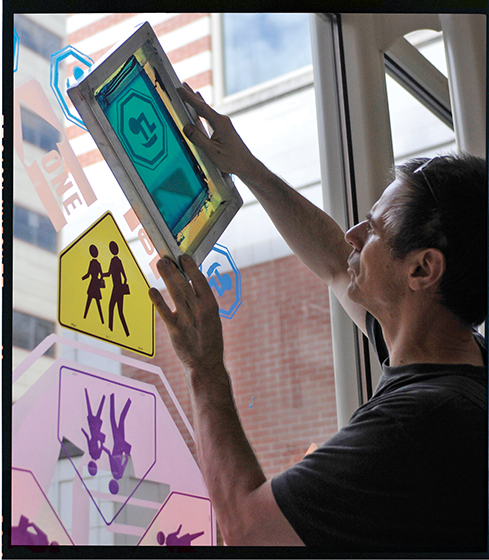 Spring 2015
Spring 2015|
Stefan Hoffmann
Living a nomadic life isn’t a side effect of Stefan Hoffmann’s work, it’s the heart of it. With each project, the German-born, Holland-based artist spends weeks on location, learning the culture of towns such as Montreal, Tokyo, and for several projects over five years, Pittsburgh. After an invitation to do a residency at North-Side-based printmaking studio Artists Image Resource, Hoffmann began a collaboration with The Andy Warhol Museum, creating his signature site-specific artwork at a community center in Rankin. The result is a mural in the center’s gymnasium pairing classical statues with images of basketball stars, against a backdrop inspired by Greek geometry. As often happens, the process of making his art—a unique screen-printing method that allows Hoffmann to create prints directly on walls, windows, and other vertical surfaces—attracted the attention of the community. “This is why I like working in public,” says Hoffmann. “No safety belt. People see your thinking process, they see your failures, and they see how you move along—and, nine times out of 10, they join in and have a very positive reaction.” His work for Andy Warhol: 15 Minutes Eternal, the largest exhibition of work by Andy Warhol to tour Asia, involved getting students in Pittsburgh, Tokyo, and Shanghai to think about how a collection of imagery can communicate a sense of place. And come June, the artist will return to Pittsburgh to create a mural for The Warhol’s entrance gallery, a commission the artist considers a major challenge. “The museum’s not exactly an empty space—it’s totally occupied by Warhol, every millimeter,” he says. “How do you come to its entry and try to make a gesture that sticks?” How do you enter into a new community to start a project?This is the most crucial part of my practice. I try not to establish an idea before I’m on-site. The important thing for me is that I want to understand the context before I begin work. I like going in without knowing what I’m going to do. The imagery I use has to have a relationship to the place I’m working with. How did the Rankin Christian Center mural come to be?When I visited the gymnasium I had the initial idea of doing something with the very present lines of the basketball court—geometric lines. And then it becomes almost like cooking: you taste ingredients— Greek geometry, then ‘Olympia’ came to mind, the origin of the idea of sports as we know it, and the statues; putting people on a pedestal, literally. An important part of the project was an extensive program of workshops set up in collaboration with Artists Image Resource. We wanted to get the kids involved, and in the activities we did with them they came up with the idea of the basketball stars. That’s what made them proud to have the mural. Is it challenging working in different locations?In an art location, it can be provocative to raise the question of what the arts can be in that context. And sometimes, like in the Rankin environment, it doesn’t make sense to “conceptually elaborate on what contemporary art might be in the 21st century”—not when kids are asking, “Are you Andy Warhol?” So I set my focus elsewhere. I had kids staring at the images of Greek statues asking, “Was this a real person?” And that’s fascinating, to get the kids thinking. That’s always my intention. My work is not about making a nice decorative whatever, it’s to raise a thought, like, “What is it I’m looking at? What could this mean?” You started out as a multimedia artist before entering printmaking. How did those come together?I was invited to do a wall painting for a project, and I thought, “What if I put the screen up against the wall?” It was that eureka moment—so I put up a little print, and put it on the wall, and was totally blown away. There’s a tension between this ephemeral thing that can be gone in a second and this cave-painting idea that could stay forever and never change. So these two practices—site-specific work like I’d been doing, and printmaking—came together as one. What is ‘off-the-grid’ printing?I wanted to broaden my possibilities. Every project space that invited me, I wanted to be able to work there, regardless of having a nearby print shop or any equipment at all. So I constructed this carrying case, which I can take on a plane, with five 20-inch by 24-inch screens and everything I need nicely packaged in between them. I’m a DIY person. I like making my things and adapting them to my needs. And it’s all open source. I teach vertical and off-the-grid printing workshops on every project, and the instructional videos are on my website. People say, ‘This is your treasure, you shouldn’t share this!’ I think to the contrary—it’s only a technique. The important thing is what you do with it.
|
Three Rivers Wise · Call of the Wild · Uncrated: The Hidden Lives of Artworks · I Can Do That · President's Note · NewsWorthy · Artistic License: A Wonderful (Still) Life · First Person: Objects of Remembering · Science & Nature: Nights at the Museum · Travel Log · The Big Picture
 |
Copyright © 2017 CARNEGIE Magazine. All rights reserved. |

